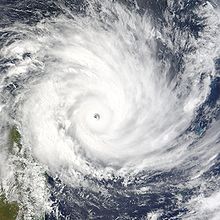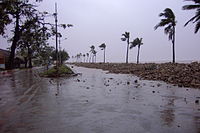- Cyclone Gafilo
-
Very Intense Tropical Cyclone Gafilo Very intense tropical cyclone (MFR) Category 5 cyclone (SSHS) 
Cyclone Gafilo at peak intensity Formed March 3, 2004 Dissipated March 11, 2004 Highest winds 10-minute sustained:
230 km/h (145 mph)
1-minute sustained:
260 km/h (160 mph)Lowest pressure 895 mbar (hPa; 26.43 inHg) Fatalities 283 total Damage $250 million (2004 USD) Areas affected Madagascar Part of the 2003-04 South-West Indian Ocean cyclone season Cyclone Gafilo was a powerful tropical cyclone which struck Madagascar in March 2004, causing devastating damage. It is the most intense cyclone ever to form in the south-western Indian Ocean.
Contents
Meteorological history
Gafilo began as a tropical disturbance on February 29, 2004 in the central Indian Ocean, south of Diego Garcia. First advisories for Tropical Disturbance 09 were issued on March 2 by the Tropical Cyclone Warning Center on La Réunion and Joint Typhoon Warning Center. At this point, it was moving to west-northwest at fairly rapid pace. Development became quicker, and next day it was named Tropical Storm Gafilo. Its forward motion also slowed, and it began to turn southwards. On March 4, Gafilo was upgraded to tropical cyclone. Next day, March 5, Gafilo began a cycle of rapid deepening with winds increasing to 145 mph (230 km/h) making it a Category 4 cyclone. It was now moving west-southwest heading straight for Madagascar. The next day, March 6, 2004 saw it reach its estimated peak intensity of 895 hPa and sustained windspeed of 160 mph (260 km/h). After midnight, Gafilo struck the northeast coast of Madagascar near to the town of Antalaha as a Category 5 cyclone, the highest possible rating.
After landfall, Gafilo continued its track to southwest, and emerged into the Mozambique Channel still at Category 1 strength. The storm then weakened as it turned southeast and made a second landfall at southwest Madagascar as a strong tropical storm. Gafilo dissipated on March 11 over southern Madagascar, with remnant low emerging over the ocean, but hostile conditions prevented regeneration.
Impact
Striking Madagascar at peak intensity, Gafilo was the strongest cyclone to ever strike the country. Torrential rain and winds in excess of 300 km/h (185 mph) battered the region. Despite its extreme intensity, wind damage was mainly limited to areas in and around Antalaha where 85% of homes were damaged or destroyed. The most significant impact resulted from fresh water flooding in northern and southwestern Madagascar.[1] In all, 172 people were killed across the country and 879 more injured.[2]
Offshore the northwestern port of Mahajanga, a ferry named Le Samson (The Samson), carrying 113 people, capsized amidst rough seas produced by the storm. Of the crew and passengers, only two survived after creating a makeshift raft and drifting to shore.[3]
Aftermath
Following the passage of the storm, the Malagasy government passed Inter-ministerial Order 17939/2004 in September 2004,[4] which cleared the way for export of new and existing stocks of rosewood as "salvage." This created anarchy in the national parks in the SAVA Region, with loggers extracting a large amounts of rosewood and ebony, grossly disproportionate to the amount of damage caused by the cyclone.[5] During this time, Marojejy National Park reported that with the granting of export rights, logging in the park had resumed.[6] It wasn't until 2006, with the passing of Inter-ministerial Order 16030/2006, that the export ban was reinstated, nearly two years after the storm, but not before the exporters lobbied the government for an extension "following the grievances expressed by operators" in October 2005, per Memorandum 923/05.[5][7] Exports were also authorized following cyclones in 2006 and 2007, encouraging the stockpiling of large quantities of lumber in both legal depots and hidden caches around the ports of Vohémar and Antalaha.[7]
See also
- List of most intense tropical cyclones
- Geography of Madagascar
- Illegal logging in Madagascar
External links
References
- ^ International Federation of Red Cross And Red Crescent Societies (March 17, 2004). "Madagascar: Cyclone Gafilo" (PDF). ReliefWeb. http://www.ifrc.org/docs/appeals/04/0804a.pdf. Retrieved March 31, 2011.
- ^ International Federation of Red Cross And Red Crescent Societies (February 25, 2005). "Madagascar: Cyclone Gafilo, Final Report, Appeal 08/04". ReliefWeb. http://www.reliefweb.int/rw/rwb.nsf/db900sid/DDAD-69XMQW?OpenDocument&rc=1&emid=2004-0103. Retrieved March 31, 2011.
- ^ Elliott Sylvester (March 12, 2004). "Ferry sinking off Madagascar leaves 111 dead: Capsized ship is result of cyclone Gafilo, which has ripped northern part of country". The Gazette (Montreal, Quebec).
- ^ Patel, E.R. (December 2007). "Logging of Rare Rosewood and Palisandre (Dalbergia spp.) within Marojejy National Park, Madagascar". Madagascar Conservation & Development 2 (1): 103–112. http://www.mwc-info.net/en/services/Journal_PDF%27s/Issue2/Logging_of_Rosewood.pdf.
- ^ a b "Investigation into the illegal felling, transport and export of precious wood in SAVA region Madagascar". Global Witness and the Environmental Investigation Agency, Inc.. August 2009. http://www.globalwitness.org/media_library_get.php/1184/1264883653/mada_report_revised_finalen.pdf. Retrieved 30 January 2010.
- ^ "Marojejy National Parks – News Updates". Marojejy National Park. November 2009. http://www.marojejy.com/Breves_e.htm. Retrieved 4 February 2010.
- ^ a b Gerety, Rowan Moore (16 December 2009). "Major international banks, shipping companies, and consumers play key role in Madagascar's logging crisis". WildMadagascar.org. http://news.mongabay.com/2009/1215-rowan_madagascar.html. Retrieved 29 January 2010.
The most powerful tropical cyclones by area of formation or impact North central Pacific Australia North Indian Ocean Northeast Pacific South Pacific Southwest Indian Ocean Cyclone Gafilo (2004)
— 895 hPaNorth Atlantic Western Pacific Categories:- 2003–04 South-West Indian Ocean cyclone season
- Cyclones in Madagascar
- 2004 in Madagascar
- Very intense tropical cyclones
Wikimedia Foundation. 2010.


